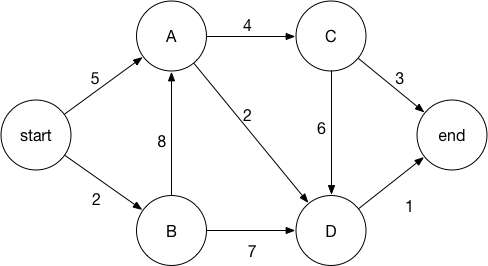package cn.like.study.algorithm;
import java.util.*;
/**
* @program: MyCode
* @description: 狄克斯特拉算法
* 算法步骤:1.判断是否有未处理的节点
* 2.若有,获得其中离起点最近的节点
* 3.遍历该节点所有邻居并更行其开销
* 4.如果有邻居的开销被更新,同时更新父节点
* 5.该节点标记为已处理
* 6.重复第1步
* @author: like
* @create: 2018-04-22 10:49
**/
public class Dijkstra {
//设置没有已知到达路径的标记
private static int NOWAY_SIGN = Integer.MAX_VALUE;
private static final String START = "start";
private static final String END = "end";
public void getMinStep(String start, String end, Map<String, Map<String, Integer>> graph) {
//各节点的最少花费
Map<String, Integer> costs = graph.get(start);
//各节点最少花费时的父节点
Map<String, String> parents = new HashMap<String, String>();
//已处理的节点
HashSet<String> processed = new HashSet<String>();
//在未处理的节点中找到开销最小的节点
String node = findLowestCostNode(costs, processed);
while (node != null && graph.get(node) != null) {
int cost = costs.get(node);
//遍历当前节点的所有邻居
Iterator iterator = graph.get(node).entrySet().iterator();
while (iterator.hasNext()) {
Map.Entry<String, Integer> entry = (Map.Entry) iterator.next();
//通过node节点到该节点的最小消耗
int newCost = cost + entry.getValue();
//更新从start到该节点的最小消耗
if (!costs.containsKey(entry.getKey()) || costs.get(entry.getKey()) > newCost) {
costs.put(entry.getKey(), newCost);
parents.put(entry.getKey(), node);
}
}
//该节点加入已处理
processed.add(node);
//找出当前最小消耗的节点
node = findLowestCostNode(costs, processed);
}
printPath(parents, costs.get(END));
}
public void initParents(String start, Map<String, Integer> startGraph, Map<String, String> parents) {
Iterator iterator = startGraph.entrySet().iterator();
while (iterator.hasNext()) {
Map.Entry<String, Integer> entry = (Map.Entry) iterator.next();
parents.put(entry.getKey(), start);
}
}
/**
* 找出未处理节点中消耗最小的节点
*
* @param costs
* @param processed
* @return
*/
public String findLowestCostNode(Map<String, Integer> costs, HashSet<String> processed) {
int lowestCost = NOWAY_SIGN;
String lowestCostNode = null;
Iterator iterator = costs.entrySet().iterator();
while (iterator.hasNext()) {
Map.Entry<String, Integer> entry = (Map.Entry) iterator.next();
if (!processed.contains(entry.getKey()) && entry.getValue() < lowestCost) {
lowestCost = entry.getValue();
lowestCostNode = entry.getKey();
}
}
return lowestCostNode;
}
public void printPath(Map<String, String> parents, int cost) {
Stack<String> stack = new Stack<String>();
String parent = parents.get(END);
while (parent != null) {
if (START.equalsIgnoreCase(parent)) {
stack.push(START);
break;
}
stack.push(parent);
parent = parents.get(parent);
}
StringBuffer path = new StringBuffer();
while (!stack.empty()) {
String node = stack.pop();
if (path.length() != 0) {
path.append("->");
}
path.append(node);
}
System.out.println("最优路线:" + START + "->" + path.toString() + "->" + END);
System.out.println("其开销为:" + cost);
}
public static void main(String[] args) {
Map<String, Map<String, Integer>> graph = new HashMap<String, Map<String, Integer>>();
Map<String, Integer> start = new HashMap<String, Integer>();
start.put("A", 5);
start.put("B", 2);
graph.put(START, start);
Map<String, Integer> a = new HashMap<String, Integer>();
a.put("C", 4);
a.put("D", 2);
graph.put("A", a);
Map<String, Integer> b = new HashMap<String, Integer>();
b.put("A", 8);
b.put("D", 7);
graph.put("B", b);
Map<String, Integer> c = new HashMap<String, Integer>();
c.put("D", 6);
c.put(END, 3);
graph.put("C", c);
Map<String, Integer> d = new HashMap<String, Integer>();
d.put(END, 1);
graph.put("D", d);
Dijkstra dijkstra = new Dijkstra();
dijkstra.getMinStep(START, END, graph);
}
}
测试示例:

输出结果:
最优路线:start->A->D->end
其开销为:8